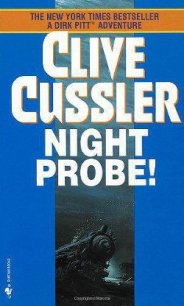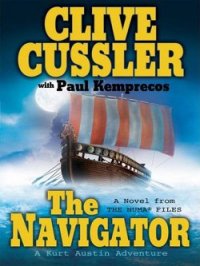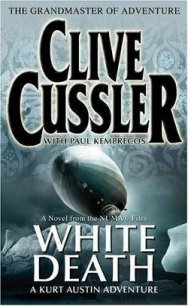Inca Gold - Cussler Clive (читать онлайн полную книгу .TXT) 📗
"There it is, gentlemen," he sighed with relief. "Now we have to soak the strands in a very mild cleaning solution to remove stains and corrosion. This process will then be followed by a chemical preservation procedure in our lab."
"How long before you can return it to Yaeger for study?" asked Sandecker.
Straight shrugged. "Six months, maybe a year."
"You've got two hours," said Sandecker without batting an eye.
"Impossible. The metal coils lasted as long as they did because they were sealed in a box that was almost airtight. Now that they're fully exposed to air they'll quickly begin to disintegrate."
"Certainly not the ones spun from gold," said Pitt.
"No, gold is practically indestructible, but we don't know the exact mineral content of the other tinted coils. The copper, for instance, may have an alloy that crumbles from oxidation. Without careful preservation techniques they might decay, causing the colors to fade to the point of becoming unreadable."
"Determining the color key is vital to deciphering the quipu, " Gunn added.
The mood in the room had suddenly turned sour. Only Yaeger seemed immune. He wore a canny smile on his face as he gazed at Straight.
"Give me thirty minutes for my scanning equipment to measure the distances between the knots and fully record the configuration, and you can keep the thing in your lab until you're old and gray."
"That's all the time you'll need?" Sandecker asked incredulously.
"My computers can generate three-dimensional digital images, enhanced to reveal the strands as vividly as they were when created four hundred years ago."
"Ah, but it soothes the savage beast," Giordino waxed poetically, "to live in a modern world."
Yaeger's scan of the Drake quipu took closer to an hour and a half, but when he was finished the graphics made it look better than when it was brand new. Four hours later he made his first breakthrough in deciphering its message. "Incredible how something so simple can be so complex," he said, gazing at the vividly colored simulation of the cables that fanned out across a large monitor.
"Sort of like an abacus," said Giordino, straddling a chair in Yaeger's computer sanctuary and leaning over the backrest. Only he and Pitt had remained with Yaeger. Straight had returned to his lab with the quipu while Sandecker and Gunn went off to a Senate committee hearing on a new underwater mining project.
"Far more complicated." Pitt was leaning over Yaeger's shoulder, studying the image on the monitor. "The abacus is basically a mathematical device. The quipu, on the other hand, is a much more subtle instrument. Each color, coil thickness, placement and type of knot, and the tufted ends, all have significance. Fortunately, the Inca numerical system used a base of ten just like ours."
"Go to the head of the class." Yaeger nodded. "This one, besides numerically recording quantities and distances, also recorded a historical event. I'm still groping around in the dark, but, for example. . ." He paused to type in a series of instructions on his keyboard. Three of the quipu's coils appeared to detach themselves from the main collar and were enlarged across the screen. "My analysis proves pretty conclusively that the brown, blue, and yellow coils indicate the passage of time over distance. The numerous smaller orange knots that are evenly spaced on all three coils symbolize the sun or the length of a day."
"What brought you to that conclusion?"
"The key was the occasional interspacing of large white knots."
"Between the orange ones?"
"Right. The computer and I discovered that they coincide perfectly with phases of the moon. As soon as I can calculate astronomical moon cycles during the fifteen hundreds, I can zero in on approximate dates."
"Good thinking," said Pitt with mounting optimism. "You're onto something."
"The next step is to determine what each cable was designed to illustrate. As it turns out, the Incas were also masters of simplicity. According to the computer's analysis, the green coil represents land and the blue one the sea. The yellow remains inconclusive."
"So how do you read it?" asked Giordino.
Yaeger punched two keys and sat back. "Twenty-four days of travel over land. Eighty-six by sea. Twelve days in the yellow, whatever that stands for."
"The time spent at their destination," Pitt ventured.
Yaeger nodded in agreement. "That figures. The yellow coil might denote a barren land."
"Or a desert," said Giordino.
"Or a desert," Pitt repeated. "A good bet if we're looking at the coast of northern Mexico."
"On the opposite side of the quipu," Yaeger continued, "we find cables matching the same blue and green colors, but with a different number of knots. This suggests, to the computer, the time spent on the return trip. Judging by the additions and shorter spacing between knots, I'd say they had a difficult and stormy voyage home."
"It doesn't look to me as if you're groping in the dark," said Pitt. "I'd say you have a pretty good grasp of it."
Yaeger smiled. "Flattery is always gratefully accepted. I only hope I don't fall into the trap of inventing too much of the analysis as I go."
The prospect did not sit well with Pitt. "No fiction, Hiram. Keep it straight."
"I understand. You want a healthy baby with ten fingers and ten toes."
"Preferably one holding a sign that says `dig here,' " Pitt said in a cold, flat voice that almost curled Yaeger's hair, "or we'll find ourselves staring down a dry hole."
High on the funnel-shaped peak of a solitary mountain that rises like a graveyard monument in the middle of a sandy desert there is an immense stone demon.
It has stood there, legs tensed as if ready to spring, since prehistoric times, its claws dug into the massive basalt rock from which it was carved. In the desert tapestry at its feet ghosts of the ancients mingle with the ghosts from the present. Vultures soar over it, jackrabbits leap between its legs, lizards scurry over its giant paws.
From its pedestal on the summit, the beast's snakelike eyes command a panoramic vista of sand dunes, rocky hills and mountains, and the shimmering Colorado River that divides into streams across its silted delta before merging with the Sea of Cortez.
Exposed to the elements on the top of the mountain, which is said to be mystic and enchanted, much of the intricate detail of the sculpture has been worn away. The body appears to be that of a jaguar or a huge cat with wings and a serpent's head. One wing still protrudes above a shoulder, but the other has long since fallen on the hard, rocky surface beside the beast and shattered. Vandals have also taken their toll, chipping away the teeth from the gaping jaws and digging their names and initials on the flanks and chest.
Weighing several tons and standing as high as a bull elephant, the winged jaguar with the serpent's head is one of only four known sculptures produced by unknown cultures before the appearance of the Spanish missionaries in the early fifteen hundreds. The other three are static crouching lions in a national park in New Mexico that were far more primitive in their workmanship.
Archaeologists who had scaled the steep cliffs were mystified as to its past, They had no way of guessing its age or who carved the beast from one enormous outcropping of rock. The style and design were far different from any known artifacts of the prehistoric cultures of the American Southwest. Many theories were created, and many opinions offered, but the enigma of the sculpture's significance remained shrouded in its past.




